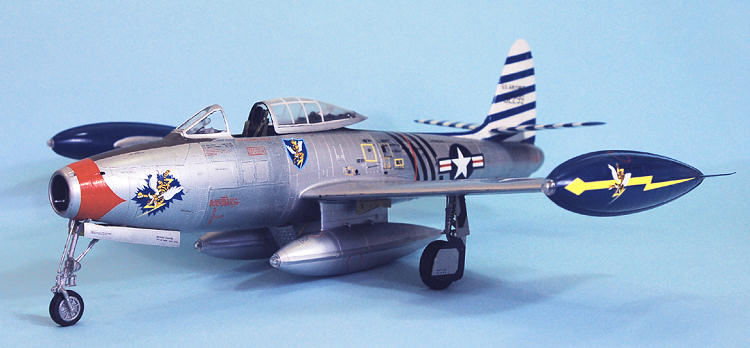
Hobby Boss 1/32 F-84E Thunderjet
| KIT #: | 3207 |
| PRICE: | 7,840 yen (approx $99) at www.hlj.com |
| DECALS: | Two options |
| REVIEWER: | Tom Cleaver |
| NOTES: | Zotz decals |

| HISTORY |
The Republic F-84 Thunderjet was the second
The F-84E was the first of the Thunderjet series to
achieve the performance expected in the design, and the first sub-type to
achieve large-scale production.
This airplane was longer than the F-84D and earlier
versions, which provided a fineness ratio to the fuselage that resulted in a top
speed just over 600mph.
The aircraft was also capable of carrying a substantial
ordnance load in the fighter-bomber role, and had the range to be an effective
bomber escort.
The F-84E originally went into production in 1949 to be used by
Strategic Air Command in the fighter-escort role, and equipped the 27th Fighter
Escort Wing, led by the legendary Colonel Don Blakeslee, and the 31st Fighter
Escort Wing, led by the less well-known but equally effective Colonel "Mac"
McColpin, the only American to have commanded all three Eagle Squadrons in the
RAF.
The Air Force was reluctant to send the "first string"
to the Korean War, since most of the top command saw Korea as a sideshow that
might turn out to be Act One of World War
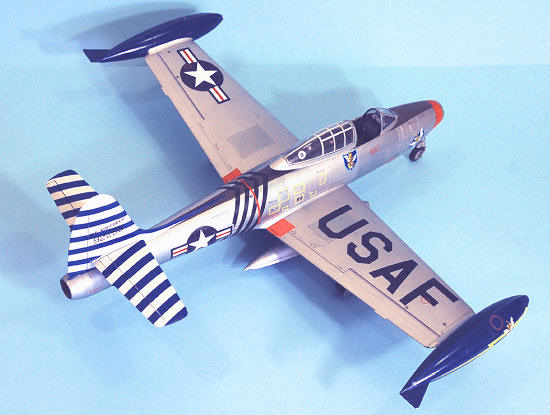 This attitude was slightly modified when the Soviet
MiG-15 showed up over the Yalu in early November.
While the F-80s of the 51st Fighter Interceptor Wing
seemed able to hold off the new fighter, it was obvious that this was only due
to superior pilot training, since the first-generation F-80 was obviously
completely outclassed by the second-generation MiG.
The Sabres of the 4th Fighter Interception wing and the
Thunderjets of the 27th Fighter Escort Wing were alerted to move to Korea in
late November and arrived in the theater in early December 1950, as UN forces
reeled down the Korean Peninsula following the intervention of the Red Chinese
army in the conflict.
This attitude was slightly modified when the Soviet
MiG-15 showed up over the Yalu in early November.
While the F-80s of the 51st Fighter Interceptor Wing
seemed able to hold off the new fighter, it was obvious that this was only due
to superior pilot training, since the first-generation F-80 was obviously
completely outclassed by the second-generation MiG.
The Sabres of the 4th Fighter Interception wing and the
Thunderjets of the 27th Fighter Escort Wing were alerted to move to Korea in
late November and arrived in the theater in early December 1950, as UN forces
reeled down the Korean Peninsula following the intervention of the Red Chinese
army in the conflict.
Don Blakeslee led the first F-84E mission over
The 49th Fighter-Bomber Group - which had operated the F-80C
since Day One of the Korean War, was re-equipped with F-84Es in the late Spring
of 1951, just before the 27th FEW was to return to the U.S.
The 49th's Thunderjets were among the most colorful of
the period, with the red-and-white, black-and-white and black-and-yellow rudder
stripes that differentiated the 7th, 8th and 9th Fighter-Bomber Squadrons that
made up the group.
The F-84E would also set a standard for future Air Force fighters
by becoming the first capable of air-to-air refueling when probes for the
British "probe-and-drogue" system were fitted to the airplane's tip tanks; two
different long-range missions to the Yalu were flown out of Japan to prove the
system after the F-84Es had been flown across the Pacific non-stop from Hawaii
to Japan.
Robert L. Scott Jr. Tours
In the fall of 1951, Colonel Robert L. Scott, Jr., had
commanded the 36th Fighter-Bomber
Wing at Furstenfeldbruck AFB in the American occupation zone of West Germany for
a year, following his creation of the Jet Fighter School at Williams AFB in
Arizona.
The wing, based furthest east in
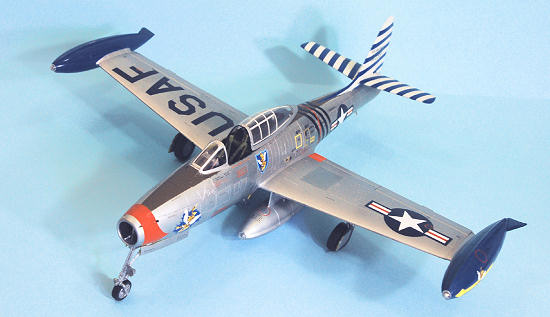 Scott sold USAFE on the fact that no Air Force aircraft
had operated in Africa south of Wheelus AFB in Libya since the Second World War,
and that a survey of the flight facilities available in the "dark continent"
would provide information of use to Air Force planning.
Scott sold USAFE on the fact that no Air Force aircraft
had operated in Africa south of Wheelus AFB in Libya since the Second World War,
and that a survey of the flight facilities available in the "dark continent"
would provide information of use to Air Force planning.
The mission took place in November 1951, and involved
Scott and a wingman flying down to Wheelus AFB outside
Yours truly had the great privilege of meeting General Scott - one of my heroes as both a pilot and a writer - at the 1984 American Fighter Aces Association convention, where he gave me the best compliment I've ever received as a writer, telling me that an article I had written about Chuck Yeager that had been published earlier that year in "Retired Officer" magazine was "the best, most knowledgeable article about a fighter pilot I've ever read." I truly treasure those words.
| THE KIT |
I'll refer you to Scott Van Aken's preview I will say that the surface detail on this kit is some of the most petite detail I have ever seen on any kit, and the result is very realistic, comparing it with the two F-84 fuselages that are out at Planes of Fame.
| CONSTRUCTION |
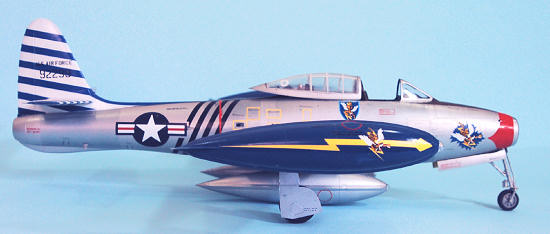
The color call-outs in the kit instructions are wrong.
The wheel wells and gear door interiors should be Yellow
Zinc Chromate.
I added some Tamiya Flat Yellow to the Tamiya Zinc Chromate
bottle and got what I was looking for.
After it dried, I applied a thin coat of Tamiya "Smoke"
to pop out detail and give the impression of oil and grease smears one would
find on the operational airplane.
Additionally, the cockpit should be Interior Green for
the floor control stick, rudder pedals, ejection seat and fore and aft
bulkheads, with the side consoles, the cockpit wall above the consoles, the
instrument panel, the gunsight, and the rear area under the canopy all Flat
Black.
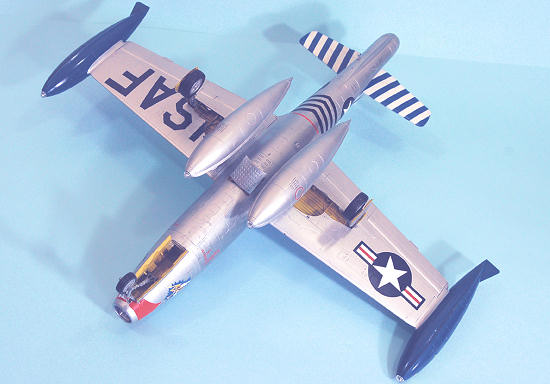 particular
angle.
This centerline brace is not standard for most F-84 canopies, but I did
find a photo of one that appears to have an additional strengthening
tape down the length of the canopy.
Fortunately, the ultimate destination of this model is
the Planes of Fame Museum, where I am sure that 99.9999999% of the visitors who
look at it will not notice this "inaccuracy."
It would be nice if someone like Falcon would do a
vacuform; it would have been nicer for Hobby Boss to include both canopies, as
it appeared they would from looking at the first in-box photos of the parts.
particular
angle.
This centerline brace is not standard for most F-84 canopies, but I did
find a photo of one that appears to have an additional strengthening
tape down the length of the canopy.
Fortunately, the ultimate destination of this model is
the Planes of Fame Museum, where I am sure that 99.9999999% of the visitors who
look at it will not notice this "inaccuracy."
It would be nice if someone like Falcon would do a
vacuform; it would have been nicer for Hobby Boss to include both canopies, as
it appeared they would from looking at the first in-box photos of the parts.
My big squawk about the kit as it arrives in the box is
the decals.
The "USAF" and the "buzz number" are wrong; both should be
insignia blue rather than black. Not only that, but the national insignia are
oversize.
The good news is that Zotz Decals has two F-84 sheets available.
Unfortunately, only one aircraft of all is an F-84E,
with the rest being F-84G variants, but the F-84E choice is the famous F-84E
flown by Col. Robert L. Scott Jr.
Zotz also provides complete stencil markings, which are
far superior to those on the kit decal sheet.
| COLORS & MARKINGS |
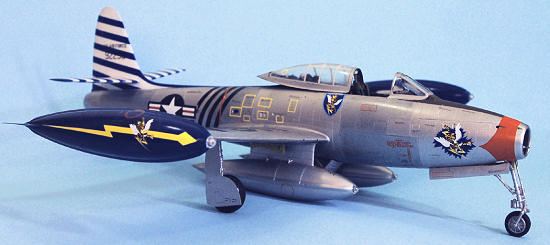
The Zotz decals went on without problem, though I did
find I needed a final application of Solvaset after Micro-Sol had been applied
and dried off, in order to get the decals to fully settle into the very petite
surface detail.
| FINAL CONSTRUCTION |
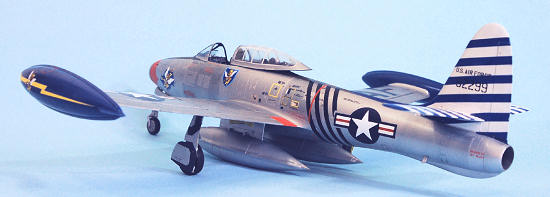
I didn't like the look of the metal landing gear, so I
used the injection plastic parts.
The model is not so heavy that these will ever give way.
I attached the landing gear and then the drop tanks.
Given this was a Wing Commander's airplane, I kept it as
clean as photos show it was in real life.
| CONCLUSIONS |
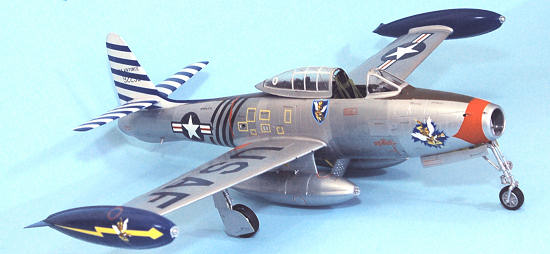
An excellent model of a great airplane, and definitely recommended.
Decals courtesy of
Zotz Decals: order yours at
www.zotzdecals.com
July 2011
If you would like your product reviewed fairly and fairly quickly, please contact the editor or see other details in the Note to Contributors.